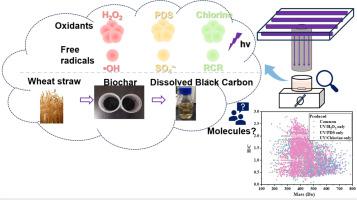当前位置:
X-MOL 学术
›
Water Res.
›
论文详情
Our official English website, www.x-mol.net, welcomes your feedback! (Note: you will need to create a separate account there.)
Molecular-level transformations of dissolved black carbon in UV-based advanced oxidation processes
Water Research ( IF 11.4 ) Pub Date : 2024-06-19 , DOI: 10.1016/j.watres.2024.121962 Qi Lu , Qi Han , Hongnan Liu , Li Feng , Yongze Liu , Ziwen Du , Liqiu Zhang
Water Research ( IF 11.4 ) Pub Date : 2024-06-19 , DOI: 10.1016/j.watres.2024.121962 Qi Lu , Qi Han , Hongnan Liu , Li Feng , Yongze Liu , Ziwen Du , Liqiu Zhang

|
Dissolved black carbon (DBC) released from biochar, is an essential group in the dissolved organic matter (DOM) pool and is widely distributed in aquatic environments. In various advanced oxidation processes (AOPs), DBC exhibits enhanced free radical scavenging compared to typical DOM, attributed to its smaller molecular weight and more compacted aromatic structure; however, the molecular-level transformations of DBC in different AOPs, such as UV/HO, UV/PDS, and UV/Chlorine, remain unclear. This study employed a DBC derived from wheat biochar for experimentation. Characterization involved ultraviolet-visible (UV–Vis) spectroscopy and fluorescence excitation-emission-matrix (EEM) spectroscopy, revealing the transformation of DBC through diminished SUVA values and reduced intensity of three-dimensional fluorescence peaks. Further insights into the transformation were gained through Fourier transform ion cyclotron resonance mass spectrometry (FT-ICR MS). After each UV-AOP treatment, a conspicuous augmentation in the oxygen content of DBC was observed. The detailed oxygenation processes were elucidated through mass difference analysis, based on 23 types of typical reactions. Results indicated that oxygenation reactions were most frequently detected in all three UV-AOP treatments. Specifically, the hydroxylation (+O) predominated in UV/HO, while the di-hydroxylation (+2O) prevailed in UV/PDS. UV/Chlorine treatments commonly exhibited tri-hydroxylation (+3O), with the identification of 1194 Cl-BPs of unknown structures. This study contributes to a comprehensive understanding of the molecular transformations of DBC induced by various free radicals in different UV-AOP processes, leading to a better understanding of the different fates of DBC in UV-AOP processes. In addition, the identification of DBC as a precursor of by-products will also contribute to the understanding of how to inhibit the generation of by-products.
中文翻译:

基于紫外线的高级氧化过程中溶解黑碳的分子级转化
从生物炭中释放的溶解黑碳(DBC)是溶解有机物(DOM)池中的重要基团,广泛分布在水生环境中。在各种高级氧化过程(AOP)中,与典型的 DOM 相比,DBC 表现出更强的自由基清除能力,这归因于其较小的分子量和更紧凑的芳香结构;然而,DBC 在不同 AOP(例如 UV/H2O、UV/PDS 和 UV/Cl)中的分子水平转化仍不清楚。本研究采用源自小麦生物炭的 DBC 进行实验。表征涉及紫外可见 (UV-Vis) 光谱和荧光激发发射矩阵 (EEM) 光谱,通过减少 SUVA 值和降低三维荧光峰强度揭示了 DBC 的转变。通过傅里叶变换离子回旋共振质谱 (FT-ICR MS) 获得了对该转化的进一步了解。每次 UV-AOP 处理后,观察到 DBC 的氧含量显着增加。基于23种典型反应,通过质量差分析阐明了详细的氧化过程。结果表明,在所有三种 UV-AOP 处理中最常检测到氧化反应。具体来说,羟基化(+O)在UV/H2O中占主导地位,而二羟基化(+2O)在UV/PDS中占主导地位。紫外线/氯处理通常表现出三羟基化 (+3O),并鉴定出 1194 个结构未知的 Cl-BP。这项研究有助于全面了解不同UV-AOP过程中各种自由基诱导的DBC分子转化,从而更好地了解DBC在UV-AOP过程中的不同命运。 此外,确定DBC作为副产物的前体也将有助于了解如何抑制副产物的产生。
更新日期:2024-06-19
中文翻译:

基于紫外线的高级氧化过程中溶解黑碳的分子级转化
从生物炭中释放的溶解黑碳(DBC)是溶解有机物(DOM)池中的重要基团,广泛分布在水生环境中。在各种高级氧化过程(AOP)中,与典型的 DOM 相比,DBC 表现出更强的自由基清除能力,这归因于其较小的分子量和更紧凑的芳香结构;然而,DBC 在不同 AOP(例如 UV/H2O、UV/PDS 和 UV/Cl)中的分子水平转化仍不清楚。本研究采用源自小麦生物炭的 DBC 进行实验。表征涉及紫外可见 (UV-Vis) 光谱和荧光激发发射矩阵 (EEM) 光谱,通过减少 SUVA 值和降低三维荧光峰强度揭示了 DBC 的转变。通过傅里叶变换离子回旋共振质谱 (FT-ICR MS) 获得了对该转化的进一步了解。每次 UV-AOP 处理后,观察到 DBC 的氧含量显着增加。基于23种典型反应,通过质量差分析阐明了详细的氧化过程。结果表明,在所有三种 UV-AOP 处理中最常检测到氧化反应。具体来说,羟基化(+O)在UV/H2O中占主导地位,而二羟基化(+2O)在UV/PDS中占主导地位。紫外线/氯处理通常表现出三羟基化 (+3O),并鉴定出 1194 个结构未知的 Cl-BP。这项研究有助于全面了解不同UV-AOP过程中各种自由基诱导的DBC分子转化,从而更好地了解DBC在UV-AOP过程中的不同命运。 此外,确定DBC作为副产物的前体也将有助于了解如何抑制副产物的产生。











































 京公网安备 11010802027423号
京公网安备 11010802027423号